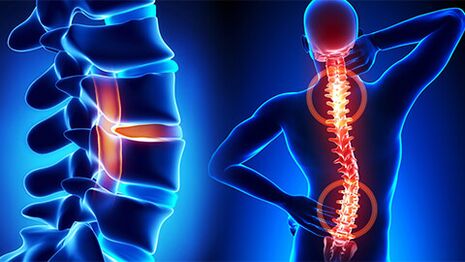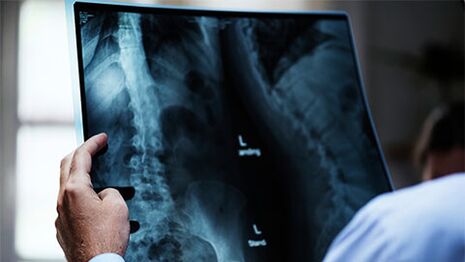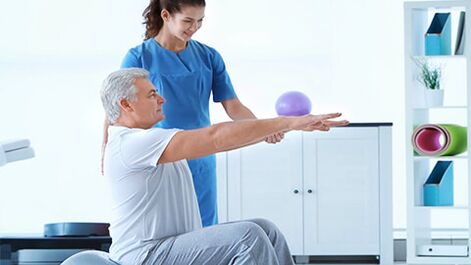
Back pain and numbness are symptoms that afflict many people. The episodic occurrence of this unpleasant sensation is possible for various reasons - prolonged inactivity, prolonged sitting or sleeping in the wrong position. The presence of such symptoms indicates the development of degenerative -dystrophic lesions on the spinal tissue - osteochondrosis.
Osteochondrosis: what is it?
Osteochondrosis is a very common disease, accounting for more than half of the cases of chronic back pain. As a result of a combination of factors (lack of nutrients in the diet, lack of physical activity, disturbed metabolic processes in the body), destructive changes begin to occur in the tissue structure of the vertebral and intervertebral discs, as well as bones and associated ligaments. This is reflected in their shape change and a decrease in elasticity.
The vertebrae are compressed and the spine loses stability in the affected area. The nerve endings of the spinal cord are pinched, as a result of which the back muscles are constantly hypertensive. Due to the displacement of the vertebrae, the risk of protrusion or intervertebral hernia, as well as spondylosis (appearance of bone processes - osteophytes), increases.
Types of osteochondrosis and its stage of development
When making a diagnosis, the place of localization of the degenerative process is taken into account. Osteochondrosis consists of 4 types:
- lumbar;
- dada;
- cervix;
- widespread (when more than one department is affected).
More often than others, osteochondrosis of the lumbar spine is diagnosed, as it contributes to upper body load.
In the early stages, osteochondrosis is hidden on the grounds of local symptoms, which is why patients do not get timely treatment and the disease continues. The stage of the disease that develops sequentially is characterized by the following characteristics:
- Intervertebral disc displacement and vertebral instability.
- Reduction of intervertebral space due to destruction of disc fibrous rings (vertebral compression).
- Deformation of the spinal line and the appearance of protrusions or intervertebral hernias due to rupture of the fibrous annulus and protrusion of the disc nucleus due to inappropriate load on them.
- The presence of bone growth (spondylosis), because the spine loses flexibility. The movement of the patient is very difficult and causes severe pain and discomfort.
As with any disease, the earlier osteochondrosis is diagnosed, the more likely it is to be successfully cured. At the same time, after stabilization of the patient's condition, lifelong prevention is necessary to eliminate the risk of relapse: exercise and a special diet. And since most modern people are at risk of developing this pathology, it’s best to start a healthy morning exercise habit now.
Causes of the development of osteochondrosis
Osteochondrosis is a disease that is more frequently diagnosed in the elderly due to the natural cause of aging of the body and slowing down of metabolic processes. However, if there is no physical activity and lead an "inactive" lifestyle, the disease can develop in young people. In this case, the weakness of the back muscles can lead to the development of degenerative processes, which interfere with blood flow and nutrition of the vertebral and intervertebral disc tissues.
Although widespreadosteochondrosis, the causehersemergencenot fully understood. A combination of factors often leads to the development of the disease, which also includes:
- damage to the nervous and musculoskeletal systems, hereditary factors; impaired physical development;
- violation of metabolic processes in the body, improper absorption of nutrients, disturbances in the work of the endocrine and digestive systems;
- lack of vitamins and minerals in the diet, unbalanced diet, frequent dehydration;
- long-term use of certain medications;
- overweight and increased stress on the spine, hard physical energy with improper load distribution;
- a sedentary lifestyle, prolonged stay in a statically uncomfortable position, for example, while working in an office;
- spinal cord injuries; transfer infectious diseases, stress.
It is possible to speak confidently about the disease if, due to the difficulty of accessing nutrients to the tissues of the intervertebral discs and vertebrae, degenerative processes begin to develop in them. In this case, regrowth becomes completely impossible, and against the background of the accompanying factors, there is a gradual destruction of the vertebrae and discs. As a result of the body’s natural self-regulating processes, osteophytes can appear in the vertebrae, a type of spine of bone tissue, which seems to narrow the intervertebral space. In this case, the flexibility of the spine is lost, and movement brings pain and discomfort.
Symptoms of the disease
If there are general similarities, the species are differentosteochondrosishave a differencesymptoms and signs. . . This is due to the fact that, depending on the location of localization, as a result of pinching the vessel, the painful sensation affects the organs and parts of the body located nearby.
For osteochondrosis of the lumbar region, pain in the lower back is characteristic with sudden movements or prolonged stay in a static position. Because of pinching the nerve endings, pain may appear in one or both legs, the nature of the pain varies from pain to shooting. By taking a comfortable position, the pain disappears.
The second most common type of osteochondrosis, cervical, is characterized by the following symptoms: the presence of dull headaches and dizziness. Unpleasant sensations increase with movement of the head, while taking analgesics does not relieve the pain syndrome. Pain can be given to the chest area, a sensation similar to an angina pectoris attack, but longer. Also, there is a sharp painful sensation in the hands and fingers, their numbness. Probably numbness of the tongue, difficulty in the implementation of speech activities.
Chest osteochondrosis is relatively rare. The main reason for its development is the curvature of the spine, more rarely injuries. This type of disease is the most difficult to diagnose because its clinical signs are similar to other diseases. In addition to the painful sensation in the back, which increases with movement and bending, with osteochondrosis of the thoracic spine, pain can occur in the heart, liver and gastrointestinal tract. There is numbness in the sternum muscles and genital function becomes weak.
Common osteochondrosis combines the symptoms of several types of osteochondrosis.
How is the diagnosis made?

When diagnosing osteochondrosis, external examination of the patient is insufficient. In addition to data collection, a neurologist or vertebrologist prescribes the following types of examinations to clarify the nature and determine the degree of damage to the spine:
- X-ray;
- MRI;
- CT scan.
The final diagnosis is made based on the results of the pictures, after which the appropriate treatment regimen is selected.
How to treat posterior osteochondrosis
Since the incidentosteochondrosisa combination of various influencing factorstreatmentalways involves multiple steps. After removal of the acute condition with the help of painkillers (if necessary) and the appointment of a balanced diet, the following methods of recovery are used:
- Exercise therapy is physical therapy, a set of exercises aimed at expanding damaged areas of the spine and normalizing muscle tone. At the same time, physical activity is limited, aimed at strengthening the back muscles and restoring the flexibility of the joints and ligaments. Exercise therapy is considered the most effective method of dealing with osteochondrosis, but should be performed under expert supervision. There are several areas of exercise therapy, which include kinesitherapy, health pathways, special simulator classes. Exercise therapy has practically no limitations, as in most cases each patient is given a set of individual exercises. You should not undergo exercise therapy in the acute stage of the disease or with a serious spinal injury.
- Physiotherapy, which has a complex of procedures aimed at reducing pain and stimulating the natural regeneration process in the vertebral and disc tissues. They use the influence of lasers, ultrasound, magnetic vibrations. As an additional method of relaxing muscles and strengthening the body in general, as well as restoring the nervous system, a course of coniferous or pearl baths can be prescribed.
- Massage is used to relieve pain and restore blood circulation in the muscles. Massage is not prescribed in the acute stage of the disease.
- Traction or traction of the spine. In this procedure, the vertebrae return to their natural position, until the load on the spine becomes even.
- Reflexotherapy, when using which the specialist acts on the reflex zone and the pain point, thus reducing the pain. It is used in conjunction with massage.
- Preventive measures that provide a significant therapeutic effect include the use of special orthopedic devices: mattresses, pillows, orthopedic shoes or soles, special corsets that support the damaged part of the spine in the correct position.
- Reception of chondroprotectors, which are a source of additional nutrition for damaged tissues. You should also introduce into the diet the use of dishes based on gelatin: jelly, jelly meat, aspic.
- According to the doctor's prescription, after passing the appropriate tests, foreign experts recommend taking vitamin D3, omega fatty acids and vitamin B complex.
What will happen if you do not treat osteochondrosis
With untimely or inaccurate treatment, osteochondrosis can lead to the development of the following pathologies:
- Vegetovascular dystonia.
- Brain oxygen starvation.
- Intervertebral hernia, which can cause impaired motor function in the arms or legs.
Methods of prevention
Prevention of osteochondrosis should be aimed at excluding factors that increase the risk of its development. This is especially true for people who have:
- genetic predisposition to spinal diseases;
- chronic diseases of the gastrointestinal tract, in which the absorption of nutrients is impaired;
- diseases associated with metabolic disorders;
- severe infectious diseases, rickets transmitted in childhood;
- spinal cord injuries;
- overweight.
Prevention is especially important for people with an inactive lifestyle, experiencing increased stress on the spine and women who are planning to have children.

The main and easiest method of preventing osteochondrosis is moderate and regular physical activity: gymnastics or swimming. It is important to monitor your body posture, not to sit in an unnatural position for a long time. During inactive work, it is necessary to rest, where arrange physical exercises - to knead stiff muscles, restore blood circulation in them.
As a rule, daily habitual movements, performed improperly, regardless of the load it bears on the spine, become an equivalent factor in the development of osteochondrosis. For example, you should avoid lifting weights, throwing away the habit of always carrying a heavy bag on the same shoulder. You cannot lift heavy objects off the floor from a standing position, first you need to sit down. While doing household chores - cooking, cleaning, washing, take the correct position - stand, do not bend.
Another secret is to wear comfortable shoes, orthopedic fit or with an orthopedic insole. It’s best to push high heels altogether, or at least not wear them all the time.



















